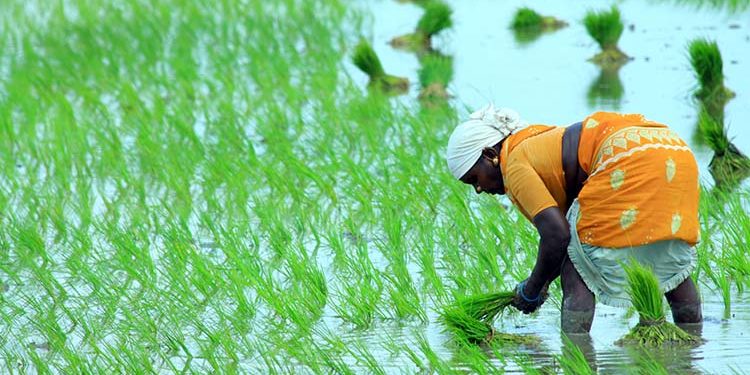Banks provide several credit facilities to customers engaged in activities related to agriculture. Many a time banks take the brunt when unforeseen disaster strikes the farmers in the form of ‘on-farm loss’ and or ‘off-farm losses. These types of losses are caused mainly due to production risk and price risk. Risk management in agriculture involves choosing among alternatives that mitigate the financial effects that can result from such uncertainties.
Production risk: on-farm risks like famine; flood, extreme weather, disease, pests, and other factors affect both the quantity and quality of commodities produced.
Price risk: off-farm risk refers to uncertainty about the prices producers will receive for commodities or the prices they must pay for inputs. The nature of price risk varies significantly from commodity to commodity.
Production risk mitigation: Using a ring gun sprayer for combating unexpected drought, (the ring gun sprayer saves water, as well as washes away pests and insects), air blowers to fight against frost, and timely spraying of pesticides, are some of the methods used by farmers to mitigate the on-farm risks. As a strategy to reduce the on-field risk, many farmers try on diversification of their crop and livestock productions, which helps a farm to compensate loss of one activity with another activity.
Price risk mitigation: One of the prominent, albeit indirect, risks in the agricultural sector is that of volatility in agricultural commodity prices. This risk is more noticeable in cases where large agricultural borrowers do not hedge the underlying agri-commodity price risk which could negatively impact such borrowers and the banks. The hedging can be through agri-commodity derivative products available on recognised exchanges in India. There is a need to create awareness among agriculture borrowers about the suitability and appropriateness of using various hedging tools so that they can make an informed decision. Currently, hedging tools including derivatives are available in the Indian market, but these are not being used extensively due to lack of awareness of the products or their inherent complexity. The informed decision on the availability and use of these instruments will reduce the scope of mis-selling of derivatives. Banks have to keep the sophistication, understanding, scale of operation, and requirements of their agri-borrowers in mind while advising them on the availability and use of these instruments.
MSP:
The Minimum Support Price or MSP is the rate at which the government buys grains from farmers. The aim of fixing MSP is to counter the price volatility of agricultural commodities due to factors like variation in their supply, lack of market integration, and information asymmetry. It is based on the recommendations of the Commission for Agricultural Costs and Prices (CACP), which is an attached office of the Ministry of Agriculture and Farmers Welfare. Read the full article: DO YOU KNOW HOW MSP IS FINALIZED BY THE GOVERNMENT?
PMFBY:
In 1999, GoI established the National Agricultural Insurance Scheme (NAIS) to reduce farmers’ vulnerability to natural disasters. The NAIS offers insurance for food crops, oilseeds, and selected commercial crops through a state-owned insurer, Agriculture Insurance Company of India (AICI). The National Agricultural Insurance Scheme (NAIS) was replaced by the Pradhan Mantri Fasal Bima Yojana (PMFBY) in 2016. The PMFBY is administered by the Ministry of Agriculture and Farmers Welfare. Some features of the PMFBY include:
Eligibility: Farmers, including tenant farmers and sharecroppers, who grow notified crops in notified areas are eligible.
Premium: Farmers pay a uniform premium of 2% for Kharif crops, 1.5% for Rabi crops, and 5% for annual commercial and horticultural crops.
Voluntary coverage: Farmers who are not covered by other means can obtain voluntary coverage. Read the full article on PMFBY
PRADHAN MANTRI FASAL BIMA YOJANA (PMFBY)-GOVT SPONSORED CROP INSURANCE
Related articles:
- How agriculture insurance helps farmers on crop losses?
- What is hedging of Agri-Commodity Price Risk?
- WHAT IS RISK MANAGEMENT IN AGRICULTURE?





